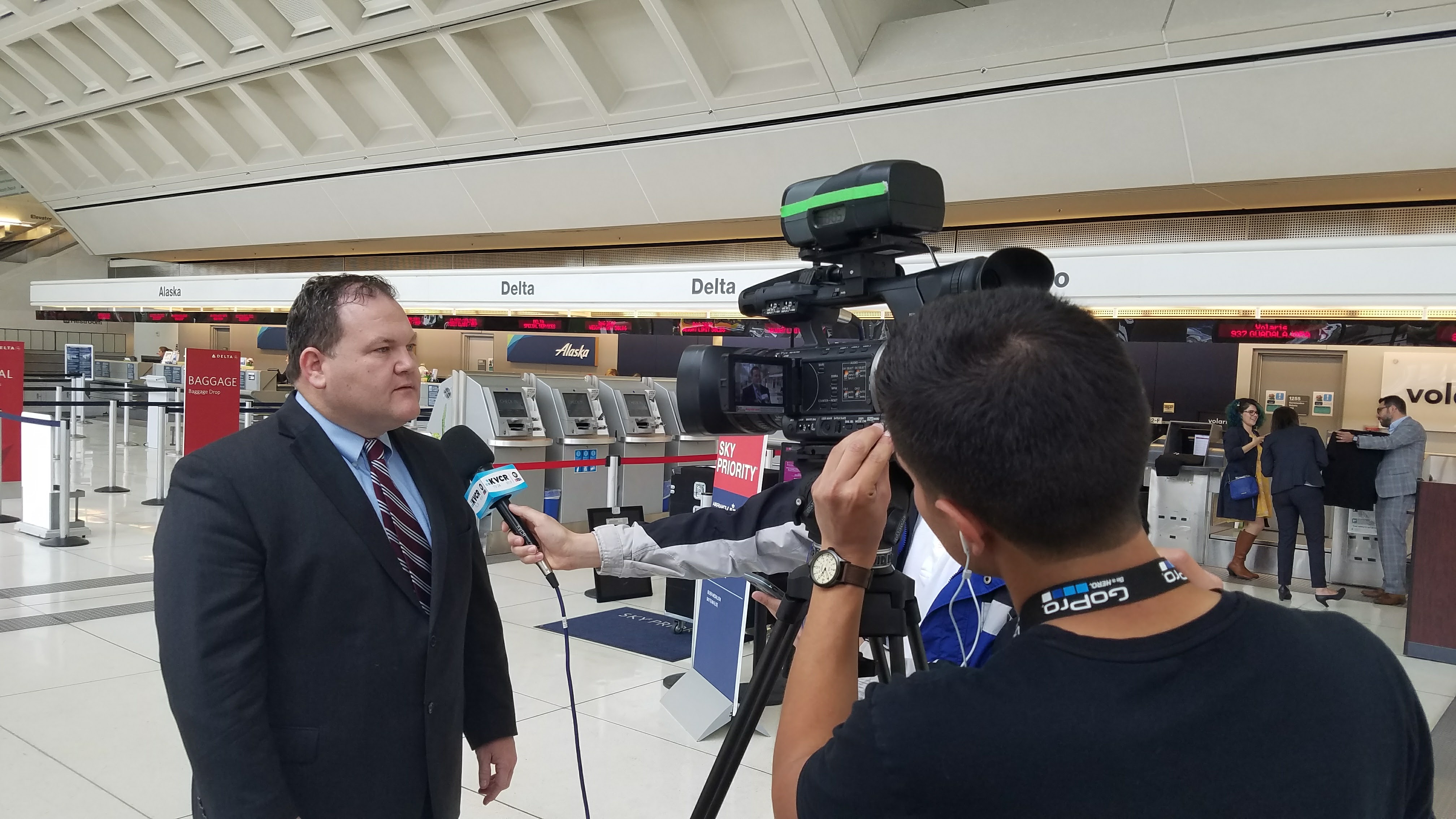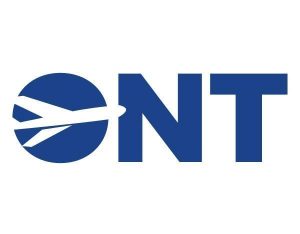Opinion
Ontario International Airport continues actions against coronavirus in time of national emergency

Ontario Airport Extends support to airport workers and business partners
By Mark Thorpe, Chief Executive Officer, Ontario International Airport Authority
As the United States faced the increasing threat posed by the coronavirus last month, we took action to protect Ontario International Airport (ONT) customers and those who work in the airport. We worked closely with federal, state and local public health officials and our aviation partners to determine the appropriate steps to adjust operations and effectively manage the flow of airline passengers through our airport.
In late February, we enhanced efforts to keep ONT facilities clean. We increased the frequency and intensity of cleanings of restrooms and other public areas of our passenger facilities. Hand rails, door handles, arm rests, counter tops and other common surfaces became focal points for high-powered disinfectants. More hand sanitizing stations were added throughout our terminals and airfield facilities. In our security screening areas, we had previously incorporated new passenger screening trays treated with powerful antimicrobial technology to inhibit the growth of bacteria on the surface of the bins used by travelers at TSA checkpoints. Ontario was the first U.S. airport to receive the new trays from SecurityPoint Media in partnership with Microban International.

More recently, we updated our sick leave and telecommuting policies to provide flexibility for employees and reassure any who might become ill or need to care for family at home. In the event an airport employee contracts the coronavirus, for example, our sick leave policy provides paid administrative leave for the duration of the illness. Additionally, our human resource policies have been adjusted for qualified employees to work from locations away from the airport.
While we remain vigilant in our efforts to keep our airport free of harmful bacteria and viruses, we are also committed to collaborating with our air carriers, concessionaires and other business partners to adapt our airport operations to the downturn in air travel which we are now seeing on a significant scale.
We will, for instance, support our airline and car rental partners in providing a limited amount of storage for aircraft and vehicles that are taken out of circulation as customer demand decreases. In addition, we are working closely with retail and dining concessionaires to adjust hours of operation in response to changes in airline schedules to ensure service is available for travelers when they are in our airport terminals.
As for customers continuing to patronize ONT, we are heartened by the numbers of passengers who traveled through our airport in February. Total passenger volume rose to nearly 420,000, an increase of 15.5% over February last year. Domestic travel increased 16.2% to more than 399,000, while the number of international passengers rose to almost 21,000, up 3.2% from February 2019. For the first two months of the year, travel through ONT increased 15.1% over the January-February period last year to more than 874,000.
At the same time, commercial freight shipments totaled more than 55,000 tons, almost 12% higher than last February. On a year-to-date basis, cargo shipments rose more than 8% to 116,000 tons.
| February
2020 |
February
2019 |
% Change | YTD
2020 |
YTD
2019 |
% Change | |
| Passenger Traffic | ||||||
| Domestic | 399,086 | 343,205 | 16.28% | 822,729 | 712,482 | 15.5% |
| International | 20,869 | 20,221 | 3.2% | 51,765 | 47,150 | 9.8% |
| Total | 419,955 | 363,426 | 15.55% | 874,494 | 759,632 | 15.1% |
| Air Cargo (Tons) | ||||||
| Freight | 55,029 | 49,159 | 11.94% | 116,056 | 107,405 | 8.1% |
| 1,431 | 2,127 | -32.71% | 3,018 | 4,413 | -31.6% | |
| Total | 56,460 | 51,286 | 10.09% | 119,074 | 111,818 | 6.5% |
We do anticipate volumes to be significantly lower for the month of March as the travel industry reels from restrictions on international air travel and reduced market demand for domestic travel. Aviation industry analysts predict world air traffic will decline this year for the first time since 2009.
As we continue to follow the guidance from our federal and state elected leaders and public health authorities, we remain confident in the future of air travel and the well-being of our airport, airport workers, business partners and the traveling public. We are steadfast in the belief that our public health leaders will guide us through this temporary disruption to our way of life and the threat posed by the coronavirus will be overcome. There can be no doubt that we will be stronger for the experience because, as Americans, that’s how we fly.
Opinion
Ontario International Airport Welcomes Avelo Airlines with New Nonstop Service to Sonoma County

Expansion Connects Southern California Travelers to Northern California’s Premier Wine Destination
Ontario International Airport (ONT) continues its impressive growth trajectory with the recent announcement from Avelo Airlines about their exclusive nonstop service to Sonoma County and Northern California’s renowned wine country. Starting October 10, the service will operate twice weekly on Thursdays and Sundays, connecting travelers directly to the Charles M. Schulz Sonoma County Airport (STS).
Streamlined Travel Experience
Passengers choosing Ontario International Airport are set to benefit immensely, not just from the expanded destination choices but also from the significant time savings associated with flying out of ONT. Known for its convenience and efficiency, ONT offers a more relaxed and hassle-free travel experience compared to larger, more congested airports. The smaller scale and thoughtful layout of ONT allow passengers to navigate check-ins, security, and boarding processes much more quickly, reducing the stress often associated with air travel.
Local Impact and Convenience
“Atif Elkadi, Chief Executive Officer of the Ontario International Airport Authority, highlighted the benefits of the new service, stating, “We are thrilled to add Avelo Airlines to our family of air carriers as we continue to provide exciting new destinations and travel options for the millions of Southern Californians who have made ONT their airport of choice.”
ONT’s strategic location and accessibility play a crucial role in its popularity. Situated in the heart of Southern California’s Inland Empire, the airport is conveniently reachable for residents from San Bernardino to Riverside and the surrounding suburbs. The airport’s proximity to major freeways reduces travel time to the airport itself, which is a significant advantage for local residents and businesses.
Enhanced Access to Northern California
Andrew Levy, Founder and CEO of Avelo Airlines, expressed enthusiasm about the new route, saying, “We are thrilled to announce our new nonstop service from Ontario to the Bay Area/Sonoma County, offering travelers a convenient, reliable, and affordable way to one of the most beautiful and vibrant regions in Northern California.”
Jon Stout, STS Airport Manager, also noted the mutual benefits of the new connection, “It’s fantastic to see Avelo connect Sonoma County with Ontario. This new route will bring a new level of convenience for our local residents and our neighbors in the Inland Empire.”
ONT’s continued expansion and the addition of new routes like the one to Sonoma County reflect its role as a pivotal hub in the region. With the airport on track to exceed 7 million passengers this year and recent records showing more than 650,000 passengers in June alone, ONT is setting new benchmarks in serving the community.
A Gateway to Growth
With world-class facilities and a commitment to excellent customer service, Ontario International Airport is rapidly becoming the gateway of choice for travelers seeking both domestic and international connections. Elkadi proudly asserts, “With our world-class facilities, great amenities, and unparalleled customer experiences, we are proud to connect the world to one of the most dynamic population and economic centers in the country.”
As ONT continues to expand its services and streamline travel experiences, it solidifies its position not just as a transport hub but as a significant contributor to the economic vitality of the Inland Empire.
Opinion
Surge in Unemployment Among California Youth Linked to Minimum Wage Hikes

“We have to stop touting the minimum wage as a completely harmless policy, or as some kind of remedy for poverty and income inequality… it is neither.”
In the past 18 months, California’s unemployment rate has jumped to the highest in the nation and a new analysis by Beacon Economics suggests that this peculiar increase could be a direct result of the state’s recent minimum wage hikes. Most concerning, according to the report, is that the current unemployment effect is specifically harming some of California’s most vulnerable residents—the state’s youth.
The new report highlights the fact that 90% of newly unemployed Californians over the past year and a half are under the age of 35 with the hardest hit group being teenagers. “This loss of youth work opportunity carries with it real long-run harm,” said Christopher Thornberg, Founding Partner of Beacon Economics and co-author of the new analysis. “It not only denies younger workers a critical source of income it deprives them of work experience that has been empirically shown to improve their chances of long-run success.”
While the recent rise in unemployment in California has occurred in tandem with the state’s minimum wage hikes, the relationship likely extends beyond mere correlation. According to the analysis, the jump in unemployment is incongruous with other measures of the California economy, which have continued to expand at a respectable rate. In fact, both output and household income in the state are robust and growing either faster than or similar to the nation overall. Yet, the unemployment rate in the United States as a whole has barely budged in the past 24 months.
And there is yet another anomaly: throughout the recent rise in unemployment, there has been no corresponding increase in unemployment insurance claims. If laid off tech and entertainment industry workers were driving California’s higher unemployment rate, it would almost certainly be reflected, at least to some degree, in UI claims, according to the analysis.
“For far too long, researchers and advocates alike have held up the minimum wage as a harmless and effective policy remedy for poverty and income inequality, but it is neither of those things,” said Thornberg. “Evidence has shown us that minimum wages don’t do much to address the ills they are intended to correct, but carry a substantial cost, particularly for our state’s future workers.”
Although well intentioned, Thornberg, and co-author Niree Kodaverdian, argue that higher minimum wages cause prices to increase, which end up reducing real incomes for lower-skilled workers. Available data and past empirical studies show that wage floors do very little to divert income from higher income workers to lower income ones, which is how minimum wage laws are typically characterized by proponents.
The specific effect on youth is caused because as labor costs go up relative to other inputs, employers who might have used lower-skilled, entry level workers, such as teenagers, move towards hiring older, more experienced workers, according to the analysis. The idea is that if an employer is legally obligated to pay a higher wage, they will naturally hire more skilled and productive workers to offset higher labor costs. Since those under age 25 make up nearly half of minimum wage workers, this restructuring disproportionally affects the state’s youth.
The report firmly acknowledges the need for policies to help alleviate the strain on lower income households in pricey California but argues that this particular policy remedy doesn’t work as intended, and when pushed too far, can inflict real harm on some of the state’s most vulnerable residents. Better policy options, according to the authors, include the Earned Income Tax Credit, early childhood education, and increased training for lower-skilled adults.
The full analysis can be found here.
Health & Wellness
Conquering Hanger: Smart Strategies for Balanced Blood Sugar

Stay Energized and Focused with These Proactive Tips for Managing Hunger and Mood
Wellness Tips By Sarah Goudie, Nutrition Expert & Guest Writer for IEBJ
We’ve all been there: mornings rushed, constant pivots throughout the day, and suddenly it’s 7 pm with no thought given to food. Looking back on those moments, we all know what we resort to when we’re hangry.
Irritable. Scatterbrained. Shaky. Weak. Reduced impulse control. Tanked.
It’s simply the connection between our stomach and brain, as blood sugar levels can affect the release of hormones like adrenaline and cortisol, the fight or flight and stress hormones.
So, let’s address this blood sugar regulation/hangry cycle by taking care of ourselves in a few different ways.
- Prioritize Protein and Fat Before Your Morning Coffee: Your first meal sets the tone for the day ahead. Starting with protein before your coffee or favorite pastry can help stabilize blood sugar levels and provide satisfaction and sustenance. A handy tip: prepare a batch of hard-boiled eggs or protein pancakes on your day off for convenient grab-and-go options before you head out. Trust me, cold protein pancakes make for a quick and nutritious bite on your way to work! (Try the recipe below!)
- Opt for Balanced Meals: When you have a chance to eat, even if it’s not your ideal meal, prioritize finishing your protein first, followed by your veggies and fruits. If you’re including simple carbohydrates, save those for the end of your meal. This meal sequencing helps regulate blood sugar levels and mood.
- Plan Ahead—Even Days in Advance: Sometimes, waking up 15 minutes earlier isn’t enough to ensure a nourishing breakfast and packed lunch. However, planning earlier in the week can alleviate the morning rush before you start your day. I often create a menu tailored to my work week, carefully considering seasonal foods and my personal goals. While meal prepping is fantastic if you have the time and enjoy leftovers, simply having a plan and doing the shopping can empower you and reassure you that your kitchen is stocked and ready.
- Slow Down: The quality of the foods we eat is important (think locally sourced, sustainable, clean), but so is the timing of our meals, as well as our mood and our focus while eating. Be intentional about meal times—sit down, step away from your desk, TV, or phone, and fully immerse yourself in the experience of eating. Many times, we eat quickly without being mindful. If you must eat on the go, find a quiet spot, whether it’s a park bench or pulled over in your car. Take the time to see, smell, and taste your food.
- SNACK SMART: This last tip is bolded for good reason—it has been a lifesaver for me countless times. Pack snacks. Every day. ESPECIALLY WHEN TRAVELING. We never know what the day will bring, so we must be prepared when we can’t access a full meal. Some of my favorite go-to snacks include “That’s It” bars, “RX” bars, a handful of macadamia nuts, or Paleo Valley protein sticks…not to mention my favorite reusable water bottle (complete with a straw designed to fit perfectly in my car cup holder). Being armed with snacks containing essential nutrients (fat, carbs, protein, and fiber) will help you navigate those moments when you’re tempted to make a fast food run.
*On the topic of fast food: Stay tuned for next month’s article, where I’ll unveil my top picks for healthier alternatives on those unavoidable drive-thru days!
Leaning into these proactive steps can revolutionize your approach to mindful fuel for your body. Embracing protein-rich breakfasts, balanced meal strategies, proactive planning, mindful eating habits, and smart snacking choices nourishes your body. It cultivates a deeper connection with your food and overall well-being. You can take charge of your dietary journey, one thoughtful bite at a time, and savor the rewards of a healthier, more vibrant life.
Check out my favorite protein pancake recipe!
- Servings: 6 small pancakes
- 1 large banana
- 2 large eggs
- 1/2 tsp cinnamon
- 1 tablespoon coconut oil for pan
- 1 scoop of your preferred protein powder
- 1. Preheat skillet
- 2. Blend ingredients above
- 3. Use the coconut oil to prep the pan
- 4. Cook till golden brown
- 5. Serve warm, and add some fun toppings! My go-to toppings are hemp seeds, fresh seasonal fruit, a scoop of almond butter, and a drizzle of honey.
-

 Technology2 months ago
Technology2 months agoLA Tech Week Highlights Southern California’s Expanding Tech Ecosystem
-

 Entertainment1 month ago
Entertainment1 month agoROI: Return on Insanity—Lucha VaVoom’s High-Yield Investment in the Pomona Arts Colony
-

 Food & Lifestyle2 months ago
Food & Lifestyle2 months agoFogo de Chão Heats Up Rancho Cucamonga Dining Scene
-

 Bizz Buzz4 weeks ago
Bizz Buzz4 weeks agoRegency Centers Unveils Oak Valley Village: A New Retail Hub Coming to Beaumont, CA
-

 Travel & Tourism3 weeks ago
Travel & Tourism3 weeks agoFly Ontario, Calif., to Honolulu aboard Southwest Airlines starting in June
-

 Transportation2 weeks ago
Transportation2 weeks agoRegional Leaders Launch “Coalition for Our Future” to Advance Urgent Safety Solutions for I-15 Corridor










